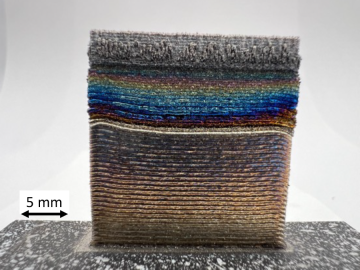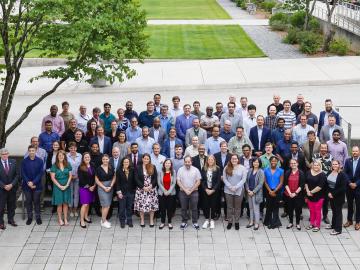
Filter News
Area of Research
- Advanced Manufacturing (2)
- Biological Systems (1)
- Biology and Environment (56)
- Building Technologies (1)
- Clean Energy (64)
- Computational Engineering (1)
- Computer Science (2)
- Electricity and Smart Grid (1)
- Energy Sciences (1)
- Fuel Cycle Science and Technology (1)
- Fusion and Fission (20)
- Fusion Energy (3)
- Isotope Development and Production (1)
- Isotopes (16)
- Materials (78)
- Materials Characterization (2)
- Materials Under Extremes (1)
- National Security (28)
- Neutron Science (33)
- Nuclear Science and Technology (2)
- Supercomputing (73)
Date
News Topics
- 3-D Printing/Advanced Manufacturing (33)
- Advanced Reactors (6)
- Artificial Intelligence (48)
- Big Data (20)
- Bioenergy (33)
- Biology (41)
- Biomedical (12)
- Biotechnology (11)
- Buildings (27)
- Chemical Sciences (38)
- Clean Water (9)
- Climate Change (52)
- Composites (10)
- Computer Science (44)
- Coronavirus (4)
- Critical Materials (10)
- Cybersecurity (9)
- Decarbonization (51)
- Education (4)
- Emergency (2)
- Energy Storage (30)
- Environment (63)
- Exascale Computing (21)
- Fossil Energy (5)
- Frontier (25)
- Fusion (15)
- Grid (23)
- High-Performance Computing (48)
- Hydropower (3)
- Irradiation (2)
- Isotopes (22)
- ITER (1)
- Machine Learning (24)
- Materials (73)
- Materials Science (31)
- Mathematics (6)
- Mercury (2)
- Microelectronics (3)
- Microscopy (9)
- Molten Salt (1)
- Nanotechnology (9)
- National Security (37)
- Net Zero (11)
- Neutron Science (42)
- Nuclear Energy (31)
- Partnerships (36)
- Physics (19)
- Polymers (9)
- Quantum Computing (23)
- Quantum Science (21)
- Renewable Energy (2)
- Security (5)
- Simulation (43)
- Software (1)
- Space Exploration (7)
- Statistics (2)
- Summit (13)
- Sustainable Energy (34)
- Transportation (30)
Media Contacts

UT-Battelle has appointed Stephen K. Streiffer to be the next director of Oak Ridge National Laboratory, joining the lab in October.

When geoinformatics engineering researchers at the Department of Energy’s Oak Ridge National Laboratory wanted to better understand changes in land areas and points of interest around the world, they turned to the locals — their data, at least.

Research into a new, unique technology to fabricate composite metal parts for a wide range of applications operating in extreme environments across the aviation, space and energy industries is showing promise for additive manufacturing.

The Spallation Neutron Source at the Department of Energy's Oak Ridge National Laboratory set a world record when its particle accelerator beam operating power reached 1.7 megawatts, substantially improving on the facility’s original design capability.

The International Standards Organization has put its stamp of approval on 18 nuclear analytical chemistry methods at ORNL. These testing and calibration methods have received ISO 17025 accreditation.

Early experiments at the Department of Energy’s Oak Ridge National Laboratory have revealed significant benefits to a dry battery manufacturing process. This eliminates the use of solvents and is more affordable, while showing promise for delivering a battery that is durable, less weighed down by inactive elements, and able to maintain a high capacity after use.

Oak Ridge National Laboratory researchers used images from a photo-sharing website to identify crude oil train routes across the nation to provide data that could help transportation planners better understand regional impacts.

Jacob McCulley of the Department of Energy’s Oak Ridge National Laboratory has been named a senior member of the Institute of Electrical and Electronics Engineers, or IEEE, one of the world’s largest technical professional

Experts across varied technology fields gathered ORNL to collaborate on the future of geospatial systems at the Trillion-Pixel GeoAI Challenge workshop. The third iteration of this event focused on multimodal advances in the field, including progress in artificial intelligence, cloud infrastructure, high-performance computing and remote sensing. These capabilities, when combined, can help solve problems in national and human security such as disaster response and land-use planning.

Over the past decade, teams of engineers, chemists and biologists have analyzed the physical and chemical properties of cicada wings, hoping to unlock the secret of their ability to kill microbes on contact. If this function of nature can be replicated by science, it may lead to products with inherently antibacterial surfaces that are more effective than current chemical treatments.


